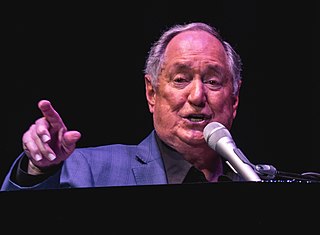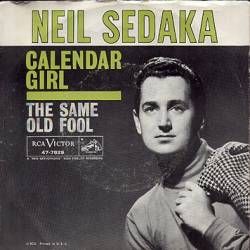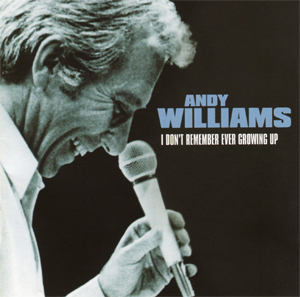
Neil Sedaka is an American singer, songwriter and pianist. Since his music career began in 1957, he has sold millions of records worldwide and has written or co-written over 500 songs for himself and other artists, collaborating mostly with lyricists Howard "Howie" Greenfield and Phil Cody.

Howard Greenfield was an American lyricist and songwriter, who for several years in the 1960s worked out of the famous Brill Building. He is best known for his successful songwriting collaborations, including one with Neil Sedaka from the late 1950s to the mid-1970s, and near-simultaneous songwriting partnerships with Jack Keller and Helen Miller throughout most of the 1960s.
"All the Way" is a song published in 1957 by Maraville Music Corporation. The music was written by Jimmy Van Heusen with lyrics by Sammy Cahn.

"Breaking Up Is Hard to Do" is a song recorded by Neil Sedaka, co-written by Sedaka and Howard Greenfield. Sedaka recorded this song twice, in 1962 and 1975, in two significantly different arrangements, and it is considered to be his signature song. Between 1970 and 1975, it was a top-40 hit three separate times for three separate artists: Lenny Welch, The Partridge Family and Sedaka's second version. The song was also adapted into multiple languages, most notably in Italian and French.
"Love Will Keep Us Together" is a song written by Neil Sedaka and Howard Greenfield. It was first recorded by Sedaka in 1973. The brother-sister duo Mac and Katie Kissoon also recorded a version in 1973. American pop duo Captain & Tennille covered it in 1975; their version became a worldwide hit.

Live at Royal Festival Hall is an album by Neil Sedaka with the Royal Philharmonic Orchestra was released on the Polydor Records label in 1974. It was recorded on February 2, 1974, at the Royal Festival Hall in London.
"Fallin'" is a song written by Neil Sedaka and Howard Greenfield, that was recorded by Connie Francis on 2 September 1958 at Metropolitan Studio (NYC) in a session produced by Morton "Morty" Kraft who also conducted.

"Stupid Cupid" is a song written by Howard Greenfield and Neil Sedaka which became a hit for Connie Francis in 1958.

"Calendar Girl" is a song by Neil Sedaka. The music was composed by Sedaka and the lyrics by Howard Greenfield. Released in December 1960 as a single, it was a hit single for Sedaka, peaking at No. 4 on the US charts, No. 3 in Australia, and No. 1 on the Canadian and Japanese charts.
"The Diary" is a song by Neil Sedaka and Howard Greenfield. It was released in 1958 as Sedaka's debut single.

Circulate is the second solo album of Neil Sedaka after his 1959 debut solo album Rock with Sedaka. Circulate was released in 1961 by RCA Victor and was produced by Al Nevins and Don Kirshner. Except for the title song "Circulate" and "I Found My World In You", the whole album contains covers of the 1930s, 1940s and 1950s songs as interpreted by Sedaka. Two of the songs were re-issued as B-sides of other hits: "I Found My World In You" was the B-side of "Sweet Little You" later in 1961, and "Circulate" was the B-side of "Alice In Wonderland" in 1963. Sedaka later recorded Italian-language versions of "Smile" and "All the Way"

Neil Sedaka Sings Little Devil and His Other Hits is a solo album by Neil Sedaka released in 1961 immediately after the cover versions of earlier hits in Circulate.

Neil Sedaka Sings His Greatest Hits is a 1963 compilation album of twelve of the most popular hits of Neil Sedaka's tenure with RCA Victor.

The Other Side of Me is the thirty-fifth studio album by American pop singer Andy Williams, released in the summer of 1975 by Columbia Records and including the 1973 recording of "Solitaire" from his album of the same name alongside 10 original recordings, four of which were also by "Solitaire" composer Neil Sedaka. After unsuccessful attempts to leave behind the formulaic album genre of easy listening covers of pop hits, The Other Side of Me offered a compromise by filling half of the sides with material that was popularized by other artists and the other half with either new or obscure selections.

I Don't Remember Ever Growing Up is the forty-third and final studio album by American pop singer Andy Williams, released in the UK by the Demon Music Group in 2007. In the liner notes of the album Williams writes, "Over the past few years I have come across songs that I really wanted to record. I picked 13 of my favorites and set out to make a new record." While the title track is the only new song, the other 12 selections were chart hits for other artists or, as is the case with "Desperado" by the Eagles, received critical acclaim without having been released as a single.

"Where the Boys Are" is a song written by Neil Sedaka and Howard Greenfield for, and first recorded by, Connie Francis as the title track of the 1960 movie by the same name in which she was co-starring.
"It Hurts to Be in Love" is a song written by Howard Greenfield and Helen Miller which was a Top Ten hit in 1964 for Gene Pitney. It was one in a long line of successful "Brill Building Sound" hits created by composers and arrangers working in New York City's Brill Building at 1619 Broadway.

The Very Best of Neil Sedaka is a 2001 compilation album issued by RCA Records as part of their commemorative "100th Anniversary" series of albums celebrating their biggest stars. The album features some of Sedaka's best-known hits during his days with RCA, recorded from 1958 to 1963.
Andrea Lee DeCapite, known by her stage name Andrea Carroll, is an American former pop singer and actress, who had a Billboard top 50 hit in 1963 with "It Hurts To Be Sixteen", and has subsequently worked as a therapist and acting coach. Now, after her marriage, she is known as Andrea Hill, PhD

"Our Last Song Together" is a 1973 song recorded by Neil Sedaka. It is a track from his LP The Tra-La Days Are Over, and was the third of four single releases from the album.













